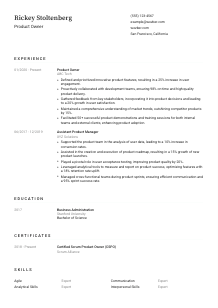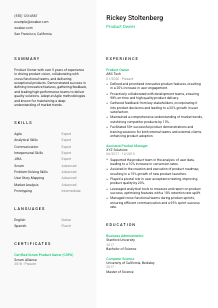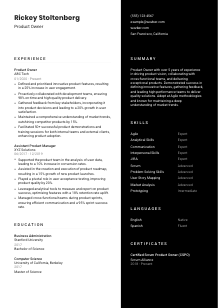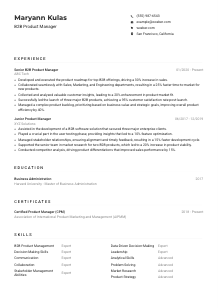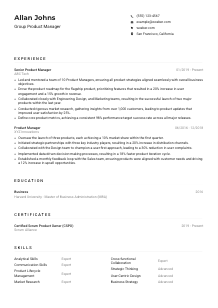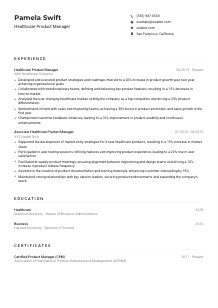Product Owner Resume Example
Navigating product visions, but your resume feels off-course? Dive into this Product Owner resume example, orchestrated with Wozber free resume builder. Learn to position your product-savvy profile in sync with job blueprints, charting a career trajectory as strategic and impactful as your roadmap launches!
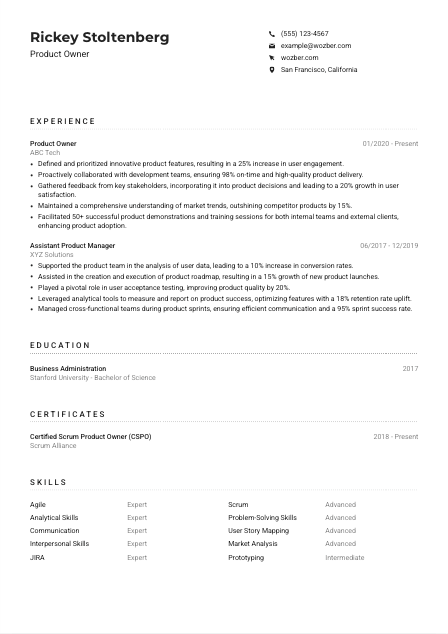
How to write a Product Owner Resume?
Hello, Visionary Product Owner! The path to landing your dream job requires more than just meeting the basic job requirements; it's about crafting a resume that showcases your unique expertise, achievements, and your knack for translating complex product visions into tangible outcomes. This guide, powered by Wozber, will walk you through creating an ATS-compliant resume tailored specifically to the Product Owner position, using an ATS-friendly resume template and ensuring your resume passes the ATS resume scanner with flying colors.
Ready to showcase your product management prowess? Let's begin your journey to success!
Personal Details
The Personal Details section, while seemingly straightforward, is your resume's handshake. It's your first shot at making a lasting impression. As a Product Owner, your attention to detail starts here, ensuring every piece of information serves a purpose and aligns with the job at hand.
1. Name as Your Brand
Think of your name as the title of your story. Use a large, clear font to make it stand out, as it's not just a name; it's an introduction to the brand that is you. It sets the professional tone for everything that follows.
2. Job Title - Align with Precision
Including the exact job title from the description beneath your name acts as immediate confirmation of your goals. This alignment shows a direct match between your aspirations and the role being offered, setting the stage for the rest of the resume.
3. Contact Info - Keep It Professional
Ensure your phone number and a professional email address (think firstname.lastname@email.com) are impeccably presented. This isn't just about providing ways to get in touch; it's about demonstrating professionalism in even the smallest details.
4. Location - A Strategic Match
"Must be located in San Francisco, CA" - when a job description specifies a location, make this an easy box for hiring managers to check off. By confirming your San Francisco, California location, you're already one step closer to being the perfect candidate.
5. Online Presence - Your Professional Window
Your LinkedIn profile or personal website can act as an extended handshake, offering a deeper insight into your professional world. Make sure they are updated and reflect the same level of professionalism as your resume.
Takeaway
By perfectly aligning your personal details with the job's requirements, you're not just sharing your contact information; you're starting a narrative that you're the ideal candidate for the Product Owner role. It's the small details that prelude your ability to handle the big ones.





Experience
The Experience section tells the story of your professional journey. But more than that, it's your opportunity to highlight specific achievements and experiences that speak directly to the role of a Product Owner. Understand that each bullet point is your chance to illustrate how your past experiences will bring success to this new role.
- Defined and prioritized innovative product features, resulting in a 25% increase in user engagement.
- Proactively collaborated with development teams, ensuring 98% on‑time and high‑quality product delivery.
- Gathered feedback from key stakeholders, incorporating it into product decisions and leading to a 20% growth in user satisfaction.
- Maintained a comprehensive understanding of market trends, outshining competitor products by 15%.
- Facilitated 50+ successful product demonstrations and training sessions for both internal teams and external clients, enhancing product adoption.
- Supported the product team in the analysis of user data, leading to a 10% increase in conversion rates.
- Assisted in the creation and execution of product roadmap, resulting in a 15% growth of new product launches.
- Played a pivotal role in user acceptance testing, improving product quality by 20%.
- Leveraged analytical tools to measure and report on product success, optimizing features with a 18% retention rate uplift.
- Managed cross‑functional teams during product sprints, ensuring efficient communication and a 95% sprint success rate.
1. Dissecting the Job Description
Analyze the job description and highlight experiences in your career that mirror these requirements. For instance, 'Work closely with development teams to ensure timely and high-quality delivery of product increments' should remind you to highlight relevant interactions and successes with development teams in your past roles.
2. List Your Roles and Their Impact
Structure your experience with clarity: job title, company, and tenure. Then, use bullet points to describe not just your responsibilities but your impact. Remember, as a Product Owner, it's not just about what you did, but about the value you added.
3. Accomplishments with Numbers
Quantify your achievements where possible. Did you increase user engagement? By how much? Numbers provide tangible proof of your success and impact. A statement like, 'Defined and prioritized innovative product features, resulting in a 25% increase in user engagement,' speaks volumes.
4. Relevance is Key
Ensure every bullet point under your roles is relevant to the Product Owner position. Focus on achievements that showcase skills like market analysis, Agile/Scrum methodologies, and cross-functional leadership, directly reflecting the job description's demands.
5. Problem-Solving and Innovation
Highlight instances where you solved complex problems or introduced innovative solutions. Product Owners are expected to navigate challenging situations and steer product development toward success – make sure your resume reflects that capability.
Takeaway
Crafting an experience section tailored to the role of a Product Owner isn't about listing all you've done; it's about showcasing the ways you've excelled and impacted your previous roles in ways that resonate with the responsibilities and challenges of the Product Owner position.
Education
In the realm of Product Ownership, your education lays the foundational knowledge upon which your experience builds. While your degrees speak to your academic achievements, tailoring this section to resonate with the job specifications can further align your background with the expectations of the role.
1. Educational Requirements
Begin by detailing the education credentials that meet the job's criteria. If the description states, "Bachelor's degree in Business, Computer Science, or related field," ensure these details are clearly mentioned, as seen with the degrees from Stanford University and the University of California, Berkeley in the resume example.
2. Presenting with Clarity
List your education history in a simple and clear manner, including the institution, degree, field of study, and graduation year. For a Product Owner, the field of study can significantly matter, showcasing a technical understanding or a knack for business strategy.
3. Tailoring Degree Details
If your degree directly relates to the role or the specified requirements, your education section should highlight this. In our resume example, both degrees are closely tied to the job description, demonstrating an ideal educational background for a Product Owner.
4. Relevant Courses or Projects
For newer grads or those with degrees not directly linked to Product Ownership, highlighting specific coursework, projects, or even thesis work relatable to product development can be beneficial. This can demonstrate a specialized focus or additional knowledge relevant to the position.
5. Additional Credentials
If you have pursued further education like online courses, workshops, or certifications relevant to product management or Agile methodologies, make sure to list them. They show a dedication to your profession and continuous learning.
Takeaway
The education section should not only meet the basic requirements but also tell a story of a candidate who has consistently aligned their learning with their career goals. For a Product Owner, showcasing both technical and business acumen through education is crucial.
Certificates
Continuing education and certifications can set you apart in the competitive field of Product Ownership. They are proof of your dedication to your profession and your commitment to staying updated with the latest trends and methodologies. Showcasing relevant certifications can give you an edge.
1. Reflecting on the Job Description
While the job description might not explicitly demand certifications, including pertinent ones like the Certified Scrum Product Owner (CSPO) can significantly bolster your credibility and align you with the preferred methodologies of the company.
2. Choose Certifications Wisely
List certifications that showcase your proficiency in skills directly relevant to being a Product Owner. Certifications in Agile, Scrum, or product management methodologies are particularly impactful, demonstrating not just knowledge, but a dedication to mastering your role.
3. Dates Matter
Include the dates of certification to showcase recency and relevance. In fields that evolve as rapidly as product management, current certifications highlight that you are up to speed with the latest practices.
4. Keep It Updated
Regularly update your certifications and seek out new opportunities to learn. The field of product development is ever-changing, and showing that you're committed to growing with it illustrates a mindset geared towards innovation and continuous improvement.
Takeaway
Certifications are not just accolades; they're testimonials to your dedication to your craft. For a Product Owner, they signify a commitment to staying at the forefront of product management practices, an attribute highly valued in this role.
Skills
The Skills section of your resume is a powerful opportunity to succinctly showcase the tools, methodologies, and personal attributes you bring to the table as a Product Owner. Formatting this section correctly and picking the right skills can significantly influence the impression you make.
1. Extract from Job Description
Start by identifying both the hard and soft skills mentioned in the job description. For a Product Owner, skills in Agile and Scrum methodologies, analytical abilities, and strong communication are often essential.
2. Match to Your Skills
Choose skills that you possess and that align with the job description. Highlighting expertise in "Agile," "Scrum," and "Analytical Skills," as well as noting your proficiency levels, shows a direct match with the employer's needs.
3. Organize for Impact
Present your skills in a clean, easy-to-read format. Prioritize them based on the job description and your strengths, ensuring that the most relevant and impressive skills catch the hiring manager's eye first.
Takeaway
Your skills section is the quick summary of why you're a great fit for the Product Owner role. It's your chance to prove you have the exact toolbox the job requires. By thoughtfully selecting and organizing your skills, you turn this section into a compelling highlight of your professional capabilities.
Languages
In an increasingly global market, the languages you speak can significantly enhance your appeal as a Product Owner. Language skills can indicate your ability to work with diverse teams and markets, a valuable asset in any product-centric role.
1. Job Requirements Insight
If the job description mentions specific language requirements, prioritize these in your resume. For instance, "Must have the ability to read complex texts in English" clearly places a premium on strong English proficiency.
2. Prioritize Language Proficiency
List languages with your proficiency levels clearly indicated. For the Product Owner role, placing languages like English at the top with a 'Native' proficiency rating directly meets the job's essential requirements.
3. Additional Languages
Even if extra languages weren't mentioned in the job description, including them can showcase your ability to communicate and operate in a global context, giving you an edge in roles that have international exposure or clients.
4. Honesty in Proficiency Levels
Accurately represent your language skills, using terms like 'Native,' 'Fluent,' 'Intermediate,' and 'Basic.' It sets realistic expectations for your role in multilingual environments or projects.
5. The Role's Global Scope
Consider the global scope of the Product Owner role. The ability to interact with users, stakeholders, and teams across different countries can be a massive asset, underscoring the value of your multilingual abilities.
Takeaway
Your linguistic prowess isn't just a personal attribute; it's a professional tool that opens up global pathways. For a Product Owner, showcasing language skills is showcasing your capacity to engage with and understand a global user base – a distinct advantage in the product world.
Summary
The Summary section is your elevator pitch, a brief opportunity to articulate why you are the ideal candidate for the Product Owner position. A compelling summary matches your experiences and skills to the job requirements, painting a picture of a candidate who's not just qualified but exceptional.
1. Capture the Job's Essence
Digest the job requirements to understand fully what the employer is looking for. As a Product Owner, focus on your prowess in driving product vision, your agile methodology expertise, and your collaborative success with cross-functional teams.
2. Start with a Hook
Begin with a punchy statement that encapsulates your professional identity and expertise. As a Product Owner, mentioning your years of experience along with a key accomplishment or specialty can immediately grab attention.
3. Address Key Attributes
Integrate skills and accomplishments that speak directly to the job description. For example, highlight your successful track record in defining product features that meet business objectives and customer needs, as well as your agile project management skills.
4. Conciseness is Key
While it's tempting to include every achievement and skill, the summary should be concise, compelling, and focused. Aim for 3-5 lines that capture the essence of your professional value as a Product Owner.
Takeaway
Your summary isn't just an introduction; it's a strategic asset. It sets the stage for your resume, highlighting your fit for the Product Owner position right from the start. It's your first, and sometimes only, chance to make a strong impression, so make it count.
Launching Your Product Owner Journey
Congratulations on taking these first critical steps toward crafting a targeted, ATS-compliant resume for the Product Owner role. With Wozber's free resume builder, including our ATS-friendly resume templates and ATS resume scanner, you're equipped to create a resume that not only passes the ATS but also captivates hiring managers. Your resume is the launchpad for your career aspirations. Refine it, personalize it, and let it propel you into your next great opportunity.
The world of product development awaits your unique talents. Make your mark!

- Bachelor's degree in Business, Computer Science, or related field.
- Minimum of 3 years of experience in a Product Owner or similar role.
- Proficiency with Agile/Scrum methodologies.
- Strong analytical and problem-solving skills.
- Excellent communication and interpersonal skills.
- Must have the ability to read complex texts in English.
- Must be located in San Francisco, CA.
- Define and prioritize product features based on business objectives and customer needs.
- Work closely with development teams to ensure timely and high-quality delivery of product increments.
- Gather feedback from stakeholders and incorporate it into product decisions.
- Maintain a deep understanding of market trends, competitor products, and industry best practices.
- Facilitate product demonstrations and training sessions for both internal teams and external users.





